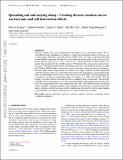Spreading out and staying sharp – creating diverse rotation curves via baryonic and self-interaction effects
Author(s)
Creasey, Peter; Sameie, Omid; Sales, Laura V; Yu, Hai-Bo; Vogelsberger, Mark; Zavala, Jesús; ... Show more Show less
DownloadAccepted version (837.5Kb)
Terms of use
Metadata
Show full item recordAbstract
© 2017 The Authors Published by Oxford University Press on behalf of the Royal Astronomical Society Galactic rotation curves are a fundamental constraint for any cosmological model. We use controlled N-body simulations of galaxies to study the gravitational effect of baryons in a scenario with collisionless cold dark matter (CDM) versus one with a self-interacting dark matter (SIDM) component. In particular, we examine the inner profiles of the rotation curves in the velocity range Vmax = [30-250] km s−1, whose diversity has been found to be greater than predicted by the ΛCDM scenario. We find that the scatter in the observed rotation curves exceeds that predicted by dark matter only mass-concentration relations in either the CDM nor SIDM models. Allowing for realistic baryonic content and spatial distributions, however, helps create a large variety of rotation curve shapes, which is in a better agreement with observations in the case of self-interactions due to the characteristic cored profiles being more accommodating to the slowly rising rotation curves than CDM. We find individual fits to model two of the most remarkable outliers of similar Vmax, UGC 5721 and IC 2574 - the former a cusp-like rotation curve and the latter a seemingly 8-kpc-cored profile. This diversity in SIDM arises as permutations of overly concentrated haloes with compact baryonic distributions versus underdense haloes with extended baryonic discs. The SIDM solution is promising and its feasibility ultimately depends on the sampling of the halo mass-concentration relation and its interplay with the baryonic profiles, emphasizing the need for a better understanding of the frequency of extreme outliers present in current observational samples.
Date issued
2017Department
Massachusetts Institute of Technology. Department of Physics; MIT Kavli Institute for Astrophysics and Space ResearchJournal
Monthly Notices of the Royal Astronomical Society
Publisher
Oxford University Press (OUP)